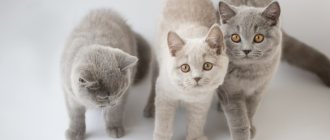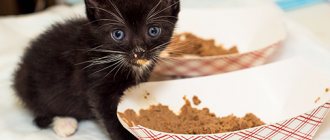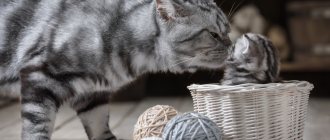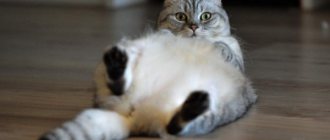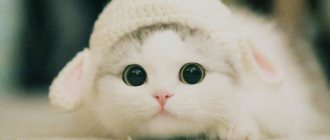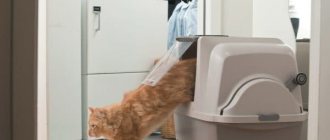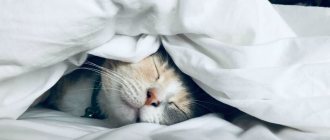9440Administration
Usually, a furry baby that appears in the house develops quickly, which certainly pleases its owners. But quite often it happens that it does not reach the required size at a certain age. An attentive owner will immediately notice this and think about why the kitten is not growing and how to fix it.
In this situation, only a veterinarian can give a complete, and most importantly, correct answer after an individual examination of the animal. After all, the topic of poor growth of pets is relevant and requires certain knowledge to correct the situation.
© shutterstock
Why doesn't the cat grow?
Usually, a furry baby that appears in the house develops quickly, which certainly pleases its owners.
But quite often it happens that it does not reach the required size at a certain age. An attentive owner will immediately notice this and think about why the kitten is not growing and how to fix it. In this situation, only a veterinarian can give a complete, and most importantly, correct answer after an individual examination of the animal. After all, the topic of poor growth of pets is relevant and requires certain knowledge to correct the situation.
Factors influencing growth
Gender also affects the size of the animal, for example, the muzzles of females are almost always narrower and more elongated than those of cats. If the cat's face stops growing, it means that the skeleton is formed, the head and shoulder width will remain at this level and will not grow any further. As a rule, this occurs by 2 years.
READ Gray cat character and habits
Internal factors
The age at which cats grow is not the only factor in an animal’s growth. There are external and internal factors influencing the development of an animal. The main internal factor is breed. Representatives of large breeds grow longer than miniature ones.
The main reasons for stopping or stunting a kitten's growth
If a kitten has problems, their consequences will become noticeable in the first month of life.
The main reasons why a kitten does not grow are::
- Poor, insufficient nutrition. In the first month of life, a kitten may suffer from a lack of milk from its mother cat. In older age, nutrition is most often simply inadequate; it lacks either nutrients or calories.
- Unbalanced diet and regimen. When a kitten does not eat well or the normal feeding regime is disrupted, then it gains little weight. In particularly advanced cases, it does not grow at all.
- Heredity or genetic abnormalities. When getting a purebred kitten, you need to know exactly what diseases it can get from its parents. This will significantly save time when identifying the reasons for poor development and will allow you to quickly decide what to do in the current situation. In addition, it is worth considering what size the pet’s parents were at the same age. It is quite possible that if the kitten is in good health, it does not grow and remains quite small, because its parents were not large either.
- Viral and infectious diseases. Often, being underweight is a consequence of past illnesses. Infections, affecting the kitten’s fragile body, lead to disruption of the gastrointestinal tract, which impairs the absorption of nutrients. Accordingly, their level in the blood decreases sharply, the organs do not receive enough of the materials they need, and the kitten grows slowly or stops gaining weight altogether.
- Infection with worms. If a kitten gets worms, this inevitably leads to sad consequences. Whatever the age of the pet, helminthic infestations will always be dangerous to its health and even life. Because of them, the kitten not only grows poorly, but can also die.
Physiological causes of weight loss
Weight gain and loss are influenced by the animal’s conditions (microclimatic, psychological), seasonal changes in the hormonal status of the cat’s body, and the animal’s character (picky eating).
Nature is calling
During the mating period, animals, especially those who go outside freely, may forget about food and lose weight. This condition does not require correction. After a period of “partying,” the form is restored.
Cold requires fat, heat requires bones
When the body temperature drops in the room in which the cat is kept, or if the animal walks freely outside in winter, the animal gains weight. Then in the spring, when it warms up, the fats are absorbed. This is normal for four-legged animals.
Emotions burn fat
If an animal experiences strong emotions, whether positive or negative, it may noticeably lose weight. If this is not constant debilitating stress, the animal does not reach exhaustion and does not require treatment.
The Joys of Motherhood
Nursing cat mothers have a good appetite, but often lose weight when nursing kittens. If there are many cubs, the animal is not able to eat as much food as is required to cover the costs. The cat will become rounder when the feeding process is completed.
Not cat food
Genetic characteristics make some pets prone to an elegant constitution. Standards for some animal breeds require noticeable slenderness. These are Siamese and Abyssinian cats, Bengal and Siamese cats, Russian Blues and some other breeds. Before classifying a cat as an excessively thin animal with an excellent appetite, it is worth reading the description of its breed. Perhaps some bonyness is the norm for this beast.
Features of age
Young active cats that move a lot can indulge in various goodies and stay in shape. Older cats (over 10 years old) also lose weight. The animal’s body simply stops accumulating excess. Sometimes this is caused by illness, but even a healthy older cat can be lean.
Feed
If the pet's food is suddenly changed, the cat may not eat it or eat less.
This will lead to some weight loss. In this case, either the animal will adapt, or it will have to return to the previous food. In this situation it usually does not reach exhaustion.
Sometimes picky cats choose tastier pieces and leave the rest of the food on the plate. Such “harmfulness” rarely lasts long. The cat may lose a little weight. But it recovers quickly.
What to do if the kitten does not grow.
As soon as it becomes noticeable that his kitten is no longer growing, you should urgently contact a veterinarian, because each case is unique and requires an individual examination. Most often, the diagnosis will be one or more of the above reasons. They are eliminated like this :
- The kitten's diet and diet are being reviewed. If tests confirm a lack of vitamins, macro and microelements, then a course of vitamin complexes is prescribed, after taking which the pet quickly grows and develops again.
- Hereditary and genetic diseases, in most families, cannot be treated. But you can always slow down their progression with medication, blunt the development of consequences and improve the kitten’s condition.
- Infectious diseases are treated with medications. Afterwards, you need to adhere to a certain diet for some time, after which the kitten grows normally again and gains weight.
- Worms are also treated with medications. But it’s better not to wait for them to appear, but to do preventive measures two or three times a year.
Thus, to find out exactly why a kitten is not growing, it is best to consult with a specialist who will identify the cause and prescribe the correct treatment for your pet.
What to do if the cat is not growing?
What should an owner do if he notices signs of slow growth or cessation in his pet? People who are interested in cats and their lives have probably heard more than once that kittens sometimes do not want to grow up. Indeed, cases where kittens grow very slowly or suddenly stop growing are not so rare.
For the development of a kitten and its growth, first of all, proper and balanced nutrition is important.
It must contain a sufficient amount of nutrients, as well as all the vitamins and minerals necessary for the growth and development of a young body.
It's no secret that animals - just like children - grow quite quickly.
How can you tell if your cat is underweight?
An animal with a deficiency of body weight, if it is short-haired or hairless, can be identified by eye. His stomach is sunken, bones protrude in the area of the sternum and pelvis, and his spine protrudes. Long-haired cats are palpated. If the muscle and fat layers are practically absent, they speak of underweight.
To objectively assess the condition of an animal, veterinarians use body mass index. To calculate it, measure the circumference of the chest and parts of the hind limb from the knee to the ankle in cm. The first number is divided by 0.7062 and the second number is subtracted. The result is divided by 0.9156 and the second digit is subtracted again. A cat's weight is considered normal when the index is between 9 and 30. If it is less, the pet is underweight.
What to do if the kitten is not growing? Why the kitten is not growing: indicators of kitten development
Domestic cats usually boast a stable appetite and approximately the same weight within ten kilograms. Why is the kitten not growing, and is it possible that the problem arose due to genetic problems in the baby’s parents?
Causes of delayed development
Why a cat is not growing is a serious question that must be resolved based on the well-being of the pet, its age and genetic indicators of the species. Growth problems in a baby may arise due to similar abnormalities in the parents. If the baby’s father or mother is not of decent size, then he could inherit this feature at the genetic level. These kids grow much slower than their peers, but at the same time they play actively and eat a lot.
Another problem that can explain what is happening is the presence of worms in the kitten. These parasites negatively affect the animal's body, preventing it from developing normally. As a result, the baby grows extremely slowly, and his immune system is always under threat.
Why doesn't the kitten that was the smallest in the litter grow? Here we can talk about insufficient nutrition from the first days of life. Those babies who are the weakest in the litter usually receive little milk. As a result, their stomach is narrowed, and in the future, even with a normal diet, the pet will consume very little food. Poor appetite will lead to the fact that the kitten will develop very slowly, and various diseases will overcome it on a regular basis.
It is difficult to make a diagnosis on your own, but you should not ignore the problem. The veterinarian will be able to assess the situation and find out why the kitten is growing so slowly.
Sometimes growth problems occur in a kitten due to problems with the digestive system. In such a situation, the cat eats a lot and consistently, but the food is poorly digested, and slow digestion negatively affects natural growth.
When to sound the alarm
It is risky to specifically fatten animals if they are not getting fat. Probably, a cat, by its breed, cannot be fat or thin. The weight of Maine Coons can reach 10 kg, and yard cats, as a rule, always remain “slender”. In order for a cat to get better, the diet changes, but the characteristics of the breed and the individual parameters of the body are first studied.
© shutterstock
You should contact your veterinarian if:
- The cat refuses food for a long time. If the animal does not gain weight, it may be due to dental disease, which can lead to a complete loss of appetite.
- Unpleasant smell. Pathologies of the gastrointestinal tract lead not only to the fact that the cat does not gain weight, but also affects the internal organs. Doctors will check your kidneys, intestines and liver.
- The animal behaves apathetically. Health problems are indicated by lethargy and sudden activity, prolonged drowsiness. This is not typical for kittens and young individuals.
- The cat has diarrhea and constant vomiting. Mild poisoning lasts no more than 2-3 days. A stomach disease is indicated by the fact that the cat does not gain weight for a long time, and meals are accompanied by vomit and loose stools.
A cat does not get fat if its diet is constantly changing. For a pet, unlike a person, monotony is optimal. This is natural food or industrial, artificially produced and offered in finished form.
Purchasing ready-made formulations from pharmacies is a priority. This is a guarantee that the food meets its production date and expiration date, is certified and has passed medical tests. If the cat does not gain weight due to illness, you can buy special medicated food.
Today, almost every person has pets. The most graceful of them are cats and female cats. Taking care of your pets from a very early age, you may encounter some problems.
When the baby is active, eats well, and has a healthy appearance, the owner should not worry. But not all owners know what to do if a small kitten does not eat well, looks exhausted and lethargic.
Ways to combat stunted growth
Why a kitten grows poorly is a natural question, and methods of dealing with the problem should be tailored to the cause of its occurrence. For example, a kitten may suddenly stop growing due to the development of infectious diseases. In such cases, babies lose their appetite, their activity decreases, and, on the contrary, their temperature increases. Infectious diseases should be treated only with special medications and only after careful consultation with a veterinarian.
If the baby has a decreased appetite, then veterinarians advise introducing special vitamins into the diet or using little tricks. 10-15 minutes before food is served to the cat, you need to lubricate its nose with milk. By licking the milk, the pet, without realizing it, will awaken its appetite, and the entire portion of the food provided will be eaten.
An unbalanced diet is a common problem that can cause a kitten to grow very slowly. It is necessary to ensure that the animal’s food contains meat, milk, and plant products. Protein is especially important for babies, as it affects growth and strengthens bones. That is why dairy products become the basis of the diet for kittens under six months of age. It is also not recommended to suddenly change the animal’s diet, otherwise its appetite may decrease, which will immediately affect the pet’s natural growth.
Sometimes developmental and growth problems occur due to the development of chronic diseases in a pet. In such cases, you have to regularly undergo medical examinations and purchase preventive medications for the cat.
Slow growth of a kitten is always an alarming symptom and should never be ignored. The faster the owner finds out the cause of such a problem, the greater the chance that it will be possible to get rid of it in time without consequences for the health of the animal.
Ways to fatten a cat
The word “fattening” itself allows for some ambiguity. It is necessary to distinguish between different understandings of this concept from the very beginning. If you want to fatten up your cat by increasing its fat layer, then you can easily do this - just focus on foods with a high fat content. Of course, such a diet will sooner rather than later hit your pet’s liver. Cats' bodies are not designed for such unlimited fat consumption.
A fat cat will never become a happy cat, even if it pleases the owner's eye
A view of fattening as restoring the health of a cat and bringing its digestion back to normal requires the development of a balanced diet, which at first will take into account the narrowed stomach of an exhausted pet. Otherwise, the diet of a fattened cat is no different from the diet of an ordinary healthy cat.
Additional help for the body
Since sometimes, with advanced emaciation, a cat experiences a pathological change in eating behavior, sometimes before fattening it is necessary to awaken the pet’s interest in food. For such purposes, there are several special recommendations:
Vitamins
Take care to provide your cat with the necessary vitamin complex, which will help restore balance to the body and accumulate nutrients that it has been denied for a long time. Pay special attention to vitamin C. In veterinary pharmacies it is sold in the form of pills. If your pet is neutral towards the tablets, you can give him the whole vitamin.
Cats consume vitamins extremely reluctantly
If the cat resists, you can crush the dragee into powder and mix it with water. The resulting solution should be drawn into a syringe and poured into the cat’s mouth. It is also possible to dissolve the crushed dragee in minced meat;
Beneficial bacteria
Give your cat lacto- and bifidobacteria half an hour before each meal. Thanks to lactic acid, these bacteria will cope with their harmful “colleagues” that have accumulated in the pet’s gastrointestinal tract during the period of dysbacteriosis.
Bifitrilak and other probiotics will help your pet’s intestines work
In addition, lactobacilli take part in increasing immunity, which is useful for both sick and healthy animals. Pribiotics that have a positive effect on the intestinal microflora and the body as a whole include Bifitrilak, Enterol, Zoonom, Subtilis and others;
Weight gain on dry food
Select your feed carefully. During periods of exhaustion, the pet’s digestive tract is especially sensitive to low-quality formulations replete with chemical additives. Therefore, it is advisable to please cats that are gaining weight with premium food and higher, which often already includes some vitamin supplements and coarse fibers that normalize intestinal function.
Dry food brands typically create special lines for pets that are gaining weight.
Specialized feed
High-end dry food has a line called Gastro Intenstinal - this is what should interest the owner. There are also canned food from the Royal Canin brand, called Rekoveri, which can be fed even through a tube in cases where the animal is not able to consume food on its own.
Royal Canin Cat Gastro Intestinal food
All these dry foods are close in composition to natural food, compressed and dried. Thus, the first places in food labeled Gastro Intenstinal include meat, high-quality offal, cereals, dairy products and carbohydrates - each of these components helps the cat maintain strength and immunity at the proper level. The pet can receive all these products in their original form on a natural diet, but dry food thinks out in advance the correct ratio of ingredients.
Canned Royal Canin Cat Gastro Intestinal for kittens
Each dry food manufacturer sets its own daily intake. As a rule, it is written on the packaging or indicated on the measuring cup included with the food. You should never increase the dose if you think your pet is malnourished and the doses are too small. The volume of granules poured does not depend on the degree of satiety. More doesn't mean better. All that is required of the owner is to comply with the limits and monitor the condition of the pet.
Excess food is more likely to lead to digestive problems in your pet than to weight gain
Gaining weight on a natural diet
If you do not have experience in creating a diet consisting of natural products, it is strongly recommended to use the knowledge of a veterinarian. We all know that cats willingly eat raw meat, drink milk and savor fish, but not everything is so simple. From allergies to parasite infestations, the natural menu has its pitfalls.
With a properly formulated diet, natural food is an ideal option for every cat.
But once you accustom your pet to a certain diet, you will be freed from the need to constantly make some changes. Cats are very strict when it comes to nutrition and tend to carry certain eating habits throughout their lives. They remain loyal to certain food categories, be it eggs or watermelon, and eat every portion with pleasure.
Recommendations
As already mentioned, emaciated individuals often experience a decrease in stomach size, which is why such cats may not be able to cope with the most standard portions. At first, give your pet food at short intervals, but in small quantities. This way he can gradually adapt his stomach to the new nutrition system.
Exhausted cats' stomachs take time to return to normal.
When creating a diet for your pet, use the following tips:
- Any piece of meat, even beef tenderloin, is carefully inspected for parasite eggs and small scraps of bone, which the pet risks injuring its esophagus.
It is advisable to avoid raw meat altogether, giving your cat boiled pieces. This way you will protect the selected pieces as much as possible; A diet of raw meat is not recommended in all cases. - It is advisable to grind the cereals thoroughly and cook longer, as this will make it easier for your pet to digest this product.
You can read everywhere about the benefits of cereals for cats as the main source of fiber. At the same time, the fact is often omitted that various cereals are the most difficult foods for both human and cat digestion; It is advisable to introduce cats to cereals from a young age. - It is acceptable to give cats milk, but in very limited quantities.
A huge number of myths are associated with cats’ love for milk, but cats’ stomachs are not adapted to digest lactose. Only kittens in the first weeks of life are shown milk (mother's milk). With excessive consumption of dairy products, cats may experience diarrhea, vomiting and other unpleasant symptoms of lactose intolerance. One bowl of milk per week is enough for your pet, if characteristic symptoms do not appear after drinking it; Lactose intolerance does not prevent cats from loving milk
Vegetables containing large amounts of B vitamins are reluctantly accepted by cats as food. To increase their interest, you can mix minced meat with vegetable puree. It is not recommended to stew vegetables, because when they boil, they release all their beneficial substances. Pay attention to tomatoes, cucumbers, cabbage, zucchini. Potatoes and beets, which are poorly digestible by animal stomachs, should be avoided.
Not all vegetables are well digested by the cat’s body.
Malnutrition
One of the most common reasons why a kitten is not growing or gaining weight is a lack of food. The smallest babies may simply not have enough mother's milk. In this case, you will have to feed the kittens manually. At an older age, the kitten does not grow due to the too meager rations that it receives. Normally, a one and a half month old baby is fed up to 5 times a day. At this age, his stomach is small and cannot accommodate large volumes, so he is fed often, in small portions.
Features of cat growth
The growth of cats is not only an increase in body length and weight gain.
Growth is the complete formation of all organs and systems in the body of an animal. However, when choosing a pet, cat lovers attach importance to external indicators: length and height of the body, weight, etc. The size of the cat depends on the breed, health status and living conditions. Often a pet stops growing due to belonging to a certain breed. The kitten begins to grow rapidly at the age of six months.
Some kittens don't grow up to be big cats because of their breed.
Stages of growth
There are four periods of cat growth (from birth to adulthood):
- The first period is neonatal. These are the first four days of a kitten's life. At this time, the weight of the animal may change (increase or decrease). The nature of the changes depends on how the birth proceeded.
- Next comes the suckling period. At this stage, the kitten is steadily gaining weight. The suckling period lasts about a month.
- The transition period lasts from four to seven weeks. At this time, the kitten's growth slows down. The animal switches to a different type of nutrition: kitten milk is replaced with solid food. After a complete transition to “teenage” nutrition, growth accelerates.
During the transition period, the kitten begins to eat solid food instead of mother's milk. - After 7–8 weeks, the post-lactation period begins. It lasts until the final formation of the body. The kitten grows independently and ceases to depend on feeding from the mother.
Unbalanced diet
An unbalanced diet is the second most common reason that a kitten does not grow or gain weight. Delay in development occurs as a result of feeding food that does not contain the substances necessary for its growth - proteins, fats, vitamins and microelements. If the animal is not fed properly, it may show signs of rickets and anemia. The kitten is not growing, the weight gain is very insignificant, it is lethargic and sits near the bowl for a long time, waiting for more nutritious food. If these signs appear, you should review your pet’s diet and adjust it according to its age.
Deviation or norm?
Before taking any measures, you need to make sure that the pet is really very thin. Each breed has its own average performance. For example, outbred cats weigh from 3.5 to 4.5 kg, British and Siberian breeds - from 5-7, Maine Coons - from 8 to 12.
Lack of weight can be determined by palpating the animal's body. If the ribs are well felt and the fat layer is insignificant, this is a deviation from the norm. In cases where the physiological causes listed below are excluded, consultation with a doctor is required.
An alarming sign is if the cat looks thin visually, its ribs, spine and pelvic bones protrude, and there is no fat layer . The stomach is sunken, and the silhouette resembles an hourglass. Such signs indicate exhaustion of the body. A veterinary examination and serious treatment is required.
Worm infestation
Worms can also lead to weight loss. In this case, the kitten does not grow or gain weight due to the fact that the parasites suck out all the nutrients from the food, leaving nothing for its owner. A characteristic sign of helminthic infestation is the animal’s good appetite with low body weight gain. The kitten is not growing or gaining weight, although it is eating well and its tummy feels firm to the touch. Constipation or diarrhea may occur. When examining stool, helminth eggs are found. How to deal with this disease is here.
Health problems as a cause of weight loss
- Dysbacteriosis. Some pets have metabolic problems from birth, while others suffer from it due to poor quality nutrition. In such a situation, it is necessary to adjust the cat’s menu and add vitamins and probiotics to it. The doctor will help you determine which probiotics your mustache needs after passing the tests.
- Presence of microparasites. Deworming needs to be done regularly.
- Dental problems. Inflammatory processes in the gums and tartar cause discomfort and the cat (even a hungry one) refuses treats. Here you need the help of a specialist.
- Oncology. Neoplasms in internal organs have a bad effect on a cat's health. If you don’t understand why your domestic cat is thin and not getting better, then first of all rule out the presence of tumors and do an ultrasound.
- Presence of internal diseases and infections. In addition to emaciation, your pet may experience other symptoms: vomiting, fever, change in stool, refusal of treats, etc. - all this signals some kind of pathology (disease of the gastrointestinal tract, liver, kidneys, etc.). At the same time, the cat may have “caught” an infection - panleukopenia, viral hepatitis, etc. Timely diagnosis is necessary here. Curing the disease will lead to weight gain.
Viral infection
Infectious diseases, colds or intestinal diseases are another common reason that a kitten is not growing or gaining weight. The mucous membrane through which nutrients are absorbed is affected. Even if the baby maintains a good appetite, the supply of proteins, fats and carbohydrates necessary for his growth and development slows down greatly or stops altogether. The kitten does not grow and does not gain weight, since its body simply has nothing to build its cells and tissues from.
Sometimes a kitten does not grow or gain weight even some time after the illness due to deep organic damage to the intestines. In this case, the recovery period is delayed and the owners feel that the kitten is not growing. In this case, there is no need to panic. A few days of a gentle diet, a course of vitamin therapy and the weight quickly returns to normal.
What to feed a natural feeding cat to help it gain weight?
Owners often believe that in order to eliminate weight deficiency, the cat needs to be fed fatty foods (lard, sour cream, pork). This is not true - fatty foods negatively affect the functioning of the digestive tract, disrupting the functioning of the pancreas and liver. The cat needs to be fed low-fat foods with high energy value, little by little but often. Dishes from the human table are contraindicated - they contain a lot of salt, fat, sugar and additives harmful to the cat.
The basis of the diet is veal, lamb, chicken, and rabbit. Meat is given boiled or raw. In the second case, it is first frozen to destroy parasites. If the animal is recovering from surgery, illness, or is severely exhausted, at first it can be given light chicken broth and baby purees with meat.
Twice a week you can give beef or chicken liver, sea fish, eggs. As an addition to meat, the diet should include porridge (oats, rice, buckwheat) and low-fat fermented milk products (kefir, fermented baked milk, cottage cheese, yogurt without additives).
Genetic abnormality
Very rarely, the reason that a kitten does not grow and does not gain weight can be a genetic anomaly, which results in dwarfism of the animal. As a rule, these are babies abandoned in early childhood by their mother cat, who have visible defects in skeletal development. Such a kitten does not grow due to underdevelopment caused by the mutation.
Unfortunately, such animals have very little chance of survival, since internal organs and the musculoskeletal system are also affected. Such a kitten does not grow, does not gain weight, and often gets sick. Its lifespan is usually no more than a few months. There is no cure. Vitamin therapy, immunostimulants and a special diet can be used as supportive measures.
In conclusion, it only remains to add that, regardless of the cause of growth retardation, you should not self-medicate, especially if there is an infectious disease or the kitten is not growing due to pathology of the internal organs. At the first signs of illness, you should contact a veterinarian who will conduct a full examination and prescribe treatment.
Did you like the article and was it useful? Please share with your friends.
Pathological causes of weight loss
With physiological weight loss, animals do not reach a state of exhaustion. If a cat's ribs are sticking out so that you can study the anatomical features of the animal through the skin, this is a sign of illness.
Helminthiasis
One of the most common causes of emaciation in a cat is infection with helminths. In the early stages of the disease, until the helminths have multiplied to large numbers, the cat’s appetite remains and even increases. At the same time, she loses weight. As the disease progresses, the animal may experience loss of appetite and stool, and may vomit.
Dental reasons
If there are problems with teeth or gums, the animal’s emaciation is not always accompanied by loss of appetite. Quite often, a cat is hungry, but cannot eat due to pain. This happens with periodontal disease, jaw injuries, or a foreign object entering the mouth (bone from a fish). Even tartar can cause your pet to lose weight. If the owner notices hypersalivation (increased salivation) in a cat, an unpleasant odor from the mouth, or bleeding gums, you should contact a specialist. If the animal approaches the plate, sniffs the food, tries to eat, then walks away, this is a sign of pain and the cat needs help from a veterinarian.
Internal illnesses
In case of pathology of internal organs, two mechanisms for losing weight in an animal can be distinguished:
- loss of appetite and decreased food intake;
- disruption of the processes of digestion and absorption of food mass.
Almost all diseases accompanied by loss of appetite and even the entry of a foreign object into the stomach can lead to weight loss.
Some endocrine diseases and problems with the digestive system lead to weight loss while maintaining the amount of food eaten. But such diseases are accompanied by a deterioration in the general condition of the animal, apathy, deterioration and hair loss, constipation or diarrhea, including blood, and vomiting.
Neoplasms
Any neoplasm of a malignant nature (not only those affecting the organs of the digestive system) can cause cachexia (exhaustion) of the animal. In this case, the animal may lose appetite, lose hair, develop a perverted taste, vomit or have diarrhea.
Infections
All serious diseases are accompanied by loss of body weight of the animal. This usually occurs due to loss of appetite and dehydration.
The most common infectious diseases for cats are calcivirosis, viral peritonitis, rhinotracheitis and panleukopenia.
All of these diseases can be fatal.
Therefore, at the first signs of illness, the animal should be shown to a veterinarian. These signs may be: copious discharge from the nose and eyes, high fever, upset stool.
Neurological disorders
With severe and prolonged stress, the animal may retain its appetite, but lose weight. If your cat becomes depressed, her appetite may decrease and she may also lose weight. There is no point in waiting until the animal gets sick. Neurological disorders require the use of sedative medications and a special diet.
Allergy
If an animal's sense of smell is reduced as a result of an allergic reaction, it may not perceive foods and dishes as food. Therefore, he will eat less and lose weight.
